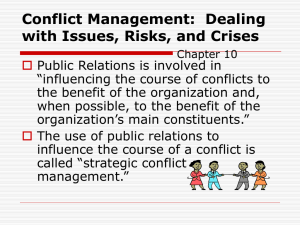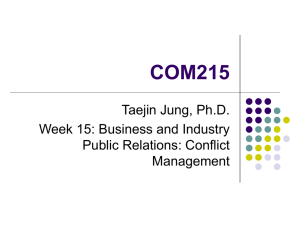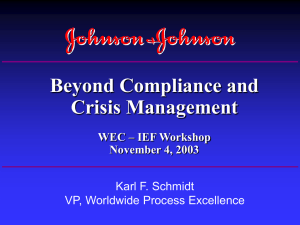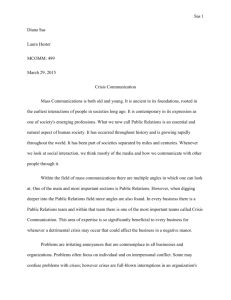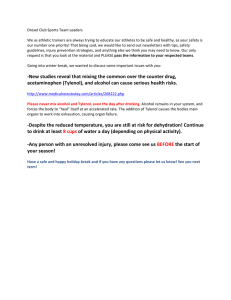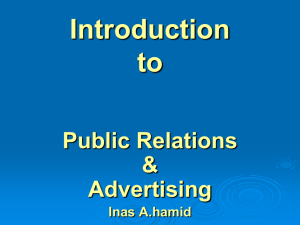H M P R
advertisement
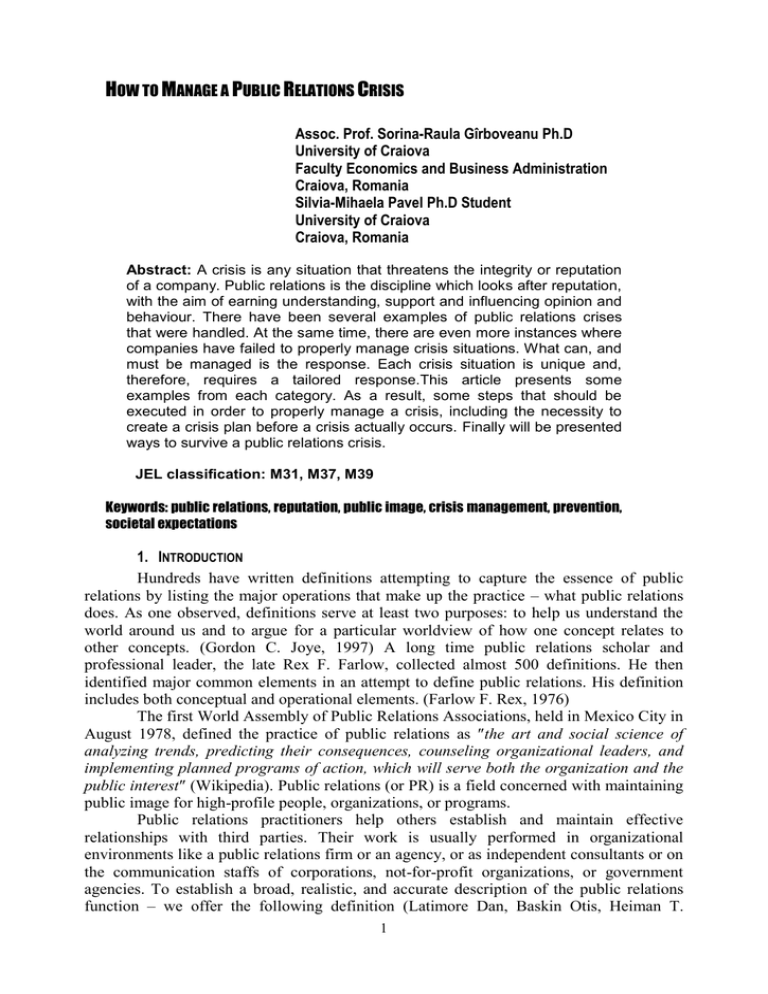
HOW TO MANAGE A PUBLIC RELATIONS CRISIS Assoc. Prof. Sorina-Raula Gîrboveanu Ph.D University of Craiova Faculty Economics and Business Administration Craiova, Romania Silvia-Mihaela Pavel Ph.D Student University of Craiova Craiova, Romania Abstract: A crisis is any situation that threatens the integrity or reputation of a company. Public relations is the discipline which looks after reputation, with the aim of earning understanding, support and influencing opinion and behaviour. There have been several examples of public relations crises that were handled. At the same time, there are even more instances where companies have failed to properly manage crisis situations. What can, and must be managed is the response. Each crisis situation is unique and, therefore, requires a tailored response.This article presents some examples from each category. As a result, some steps that should be executed in order to properly manage a crisis, including the necessity to create a crisis plan before a crisis actually occurs. Finally will be presented ways to survive a public relations crisis. JEL classification: M31, M37, M39 Keywords: public relations, reputation, public image, crisis management, prevention, societal expectations 1. INTRODUCTION Hundreds have written definitions attempting to capture the essence of public relations by listing the major operations that make up the practice – what public relations does. As one observed, definitions serve at least two purposes: to help us understand the world around us and to argue for a particular worldview of how one concept relates to other concepts. (Gordon C. Joye, 1997) A long time public relations scholar and professional leader, the late Rex F. Farlow, collected almost 500 definitions. He then identified major common elements in an attempt to define public relations. His definition includes both conceptual and operational elements. (Farlow F. Rex, 1976) The first World Assembly of Public Relations Associations, held in Mexico City in August 1978, defined the practice of public relations as ″the art and social science of analyzing trends, predicting their consequences, counseling organizational leaders, and implementing planned programs of action, which will serve both the organization and the public interest″ (Wikipedia). Public relations (or PR) is a field concerned with maintaining public image for high-profile people, organizations, or programs. Public relations practitioners help others establish and maintain effective relationships with third parties. Their work is usually performed in organizational environments like a public relations firm or an agency, or as independent consultants or on the communication staffs of corporations, not-for-profit organizations, or government agencies. To establish a broad, realistic, and accurate description of the public relations function – we offer the following definition (Latimore Dan, Baskin Otis, Heiman T. 1 Suzette, Toth L. Elizabeth, Van Leuven K. James, 2004): Public relations is a leadership and management function that helps achieve organizational objectives, define philosophy, and facilitate organizational change. Public relations practitioners communicate with all relevant internal and external publics to develop positive relationships and to create consistency between organizational goals and societal expectations. Public relations practitioners develop, execute, and evaluate organizational programs that promote the exchange of influence and understanding among an organization’s constituent parts and publics. Here is a formal three-part definition of public relations (Centrer Allen, Jackson Patrick, Smith Stacey, Stansberry R. Frank, 2008): a. Public relations is a condition common to every individual and organization in the human environment – whether or not they recognize or act upon the fact – that refers to their reputation and relationship with other members of the environment. b. Public relations is the systematized function that evaluates public attitudes and behaviours; harmonizes the goals, policies, and procedures of an individual or organization with the public interest; and executes a program of action to earn public understanding, acceptance, and supportive behaviour. c. Public relations is the full flowering of the democratic principle, in which every member of society is valued for himself or herself, and has both a right and the duty to express an opinion on public issues, and in which policies are made on the basis of free exchange of those opinions that results in public consent. In other words: Public relations is something that everyone has; public relations foster the improvement of public relations through specific activities and policies; Public relations is the cornerstone of a democratic society. The definition of public relations describes what public relations is and does, as well as how it relates to other organizational activities: Public relations is the management function that establishes and maintains mutually beneficial relationships between an organization and the publics on whom its success or failure depends. This definition of public relations positions the practice of public relations as a management function, meaning that management in all organizations must attend to public relations. It also identifies building and maintaining mutually beneficial relationships between organizations and publics as the moral and ethical basis of the profession. At the same time, it suggests criteria for determining what is and what is not public relations. (Broom M. Glenn, 2009) In today’s competitive market, reputation can be a company’s biggest asset, the thing that makes you stand out from the crowd and gives you a competitive edge. Effective PR can help manage reputation by communicating and build good relationships with all organization stakeholders. Public relations is about reputation – the result of what you do, what you say and what others say about you. Public relations is the discipline which looks after reputation, with the aim of earning understanding and support and influencing opinion and behaviour. It is the planned and sustained effort to establish and maintain goodwill and mutual understanding between an organization and its publics. Public relations take many forms in different organizations and come under many titles, including public information, marketing or customer relations. To add to all the confusion, not all of these titles always relate accurately to public relations, but all of them cover at least part of what public 2 relations is. At its best, public relations not only tell an organization’s story to the publics, it also helps to shape the organization and the way it works. Through research, feedback communication and evaluation, the practitioner needs to find out the concerns and expectations of a company’s publics and explain them to its management. (Chartered Institute of Public Relations) An organization or corporation is a group of people working together to a specific purpose. That purpose invariably involves gaining the confidence of other people who will buy the product or use the service, invest in the organization’s stock (or donate funds to nonprofit entities), and support its positions on issues. The managerial challenge is whether something is consciously done to face the fact of reputation and relationships. The approach the public relations department takes, however, is another challenge. Many companies - too many, some observers say - operate in a reactive mode. They wait for public criticism, emergencies, or bad publicity before they act. They are usually likened to firefighters who don’t get going until there’s a fire. Because reputations are formed and reformed in people’s mind continuously, and because public issues debates are constantly taking shape, a more strategic approach is to be proactive. This approach is like fire prevention. It constantly looks for opportunities and problems. Proactive public relations practitioners will be ready to take advantage of opportunities when they arise and to prevent potential problems from flaring up. (Centrer Allen, Jackson Patrick, Smith Stacey, Stansberry R. Frank, 2008) 2. CRISIS MANAGEMENT Crisis management is a professional approach to handling the crises that come up with organizations and people who are often in the public eye. Crisis management is one of the special realms of the art of public relations. Public relations consultants are trained in the arts of crisis management. A ″crisis″ is a negative event. A ″crisis″ is when something bad, unwanted, or terrible happens. (Crisis Management, 2009) The word crisis comes from the Greek krisis, meaning ″decision″. We’ve all been there. Those moments when we’re pressed in an instant to decide a course of action. Move to the left, or move to the right. Fight or flee. Offer an explanation, or dummy up tight. (Van Hook R. Steven, 2010) In the opinion of the Institute for Crisis Management a crisis is a significant business disruption that stimulates extensive news media coverage. The resulting public scrutiny will affect the organization’s normal operations. Moreover, it could have political, legal, financial and government impact on its business. Also, a crisis may be defined as any situation that is threatening or could threaten to harm people or property, seriously interrupt business, damage reputation or negatively impact share value. (Bernstein L. Jonathan, 2010) A ″crisis″, in public relations terms, is any event that draws intense, negative media coverage and interferes with normal business activity; or a highly stressful struggle or conflict within an adversarial environment. It is marked by a potentially damaging turning point that could result in financial or mortal disaster – after which things will never be the same. (Ross Dave, 2010) It can be highlighted the difference between an issue and a crisis. The difference can be understood on the basis of five parameters like speed, surfacing, scrutiny, structure and stance. A crisis happens quickly, suddenly and demands intense scrutiny whereas an issue develops gradually and generates sporadic interests from the audience. An organization’s structure needs to be rigid during a crisis, on the other hand, in case of an 3 issue, it should be fluid. The stance should be reactive in a crisis situation whereas in the case of an issue, an organization should be proactive. The public relations practitioners should also understand the relationship between the two. Crisis and issues are not two different entities, rather they share a deep relationship. One can say that if an issue is not managed timely, it can result in a crisis. (Bensilum Eddie, 2010) In other words, when an issue escalates, it may become a crisis. We can categorize crisis according to the cause of their existence or in another way, based on the warning time. Crises, like any business activity, have life cycles. The length of each phase depends on the efficiency of the management in dealing with the crisis. It is management’s responsibility to try to solve the crisis using everything it can, beginning with self confidence, going through using all the skills and ending by having the ability to absorb the public’s anger or fear without harming the firm’s income or reputation. If a manager solves a crisis without the public hearing about it, the manager has proven his brilliant capability. (The Texas State Office of Risk Management) Crises can cost organizations millions of dollars to repair or can potentially put them out of business for good. So for those looking to steer clear of any possible PR crisis, the following list outlines the principal categories that the PR disaster can spring from (McCusker Gerry, 2010): a) Acts of God. Even when natural disasters - such as a Tsunami - cause unforeseeable real life crises (and even if no-one was directly responsible for the incident) pockets of the media frequently describe how it’s a PR disaster of some sort; for tourism or even for the governments of the countries involved. b) Business Operations. This is where corporate activity adversely impacts on stakeholder groups, such as when Coca Cola and Pepsi had to defend themselves in India against allegations that their soft drinks contained excess levels of toxins. From a PR disaster viewpoint, both companies managed to fan the flames or discontent, rather than calm matters down. c) Corporate Moves. Around the time of acquisitions, mergers or takeovers, there’s plenty of room for dissatisfaction and even scandal, such as when a London PR man found himself rumbled, tried and prosecuted after indulging in a bit of insider trading. This happened after a client had confidentially told him of its plan to take over a competitor organization. d) Legalities. When contentious issues are debated in court, then reported in the media such as in the notorious McDonald’s ″McLibel″ case - the potential for PR disasters is massive. Media watchers labeled this case "the world’s biggest corporate PR disaster". e) Rumours. Gossip can be highly damaging for brand reputation, as Procter & Gamble found when malicious rumours of Satanism - in part propagated by a P&G competitor dogged the company for decades, forcing a worldwide logo redesign and extensive counter PR efforts. f) Staff. When New York’s Twin Towers collapsed on 9/11, staff at one of the city’s Starbucks charged rescue workers for bottled water they needed to treat victims of the attack. When word got out ″virally″ about this incident, the PR fallout was highly damaging. 4 g) Scandal. Financial or sexual shenanigans generally capture the media’s attention, such as when basketball star Kobe Bryant faced allegations of sexual assault. ″PR disaster″ the media screamed, as Bryant’s lucrative sponsorship deals and image as an all-round good guy were jeopardized. Human nature. When people are subjected to great emotional stress, their normally self-controlled behavior tends to become irrational and unpredictable. Their reactions turn down the steps of Maslow’s hierarchy of human needs. At the bottom, of course, are a person’s physical needs. One step above are a person’s safety needs. When people feel that physical needs and safety needs are threatened, they are prone to panic. In panic, people’s baser instincts for survival take command. This ″survival″ might be physical, financial, social, or some other component vital to a person’s life, but you can count on self-interest or self-preservation to take command of a person’s emotions and actions. These phenomena become immediately apparent in such catastrophic circumstances as fires, floods, explosions, and tornadoes. The same pattern emerges, with less severity, in noncatastrophic situations such as scarcity of gasoline or coffee, a spate of crime in a community, or even a standing-room-only crowd at a public event. Similarly, sensations approaching panic may invade us when it appears that we may miss a departing airflight, lose of a dear friend, find ourselves unexpectedly deprived of light in our home at night, or walk a dark street to our parked car. (Centrer Allen, Jackson Patrick, Smith Stacey, Stansberry R.Frank, 2008) Understand how people typically respond to issues. Philip Lesley (1984), a veteran public relations counselor and philosopher/critic of the field, developed the following model. On any given issue dividing public opinion, people will fall into these groups: 1% Immediately Favorable 45% Leaning Favorable 8% Opinion Leaders 45% Leaning Unfavorable 1% Immediately Unfavorable Zealots, minds made up as soon as they hear of the issue Have opinion won’t do anything about it Willing to discuss, open-minded will drive decision Have opinion won’t do anything about it Zealots, minds made up as soon as they hear of the issue Source: Lesley Philip, Overcoming Opposition, Upper Saddle River, NJ: Prentice Hall, 1984 Figure no. 1 Groups of people divided by public opinion Zealots will be the first to take firm stands on the issue – for and against. The majority, however, will watch to see which way the opinion leaders go before they are firm enough in their views to speak or act. Public relations efforts must focus on the opinion leaders / the 8 percent who can influence the 90 percent. Resist the temptation to capitalize on the lea lots who support your view. They anger people on both sides of the issue, 5 including those inclined to agree with them. Keep in mind that opinion leaders are rarely the visible leaders (elected officials or organization officers). Look for them at all levels and in all segments of society. The opinion leaders are not necessarily the educated and articulate, but are always the familiar and trustworthy. Most of us are inclined to seek reinforcement for our choices from people who are in the same situation we are, not from people who are ″different″. There are three smart ways to approach crisis situations (Van Hook Steven, 2010): 1) Avoid a crisis in the first place (a pinch of prevention is worth a mound of cure); 2) Quickly address and resolve crisis issues before they escalate; 3) Seek possible ways to turn your crisis into an opportunity. Dealing with a potential crisis, crisis management is crucial to the survival and reputation of the company. Depending on the situation, simply responding can help to alleviate the problem and diffuse the bomb before it goes off. 3. PLANNING FOR A CRISIS A crisis can come from nowhere at any time; natural disasters, human error (including management itself) and industrial accidents can all cause a crisis. The most serious property of crises is the element of surprise. The most dangerous thing in a crisis is not knowing about it or not being prepared for it, whether it is natural, mechanical, human error, or a management problem. The natural causes are hard to control as they happen unexpectedly. For other causes, they can be faced with the proper planning and sometimes, the plans are well-designed enough to suit and deal with even the natural causes. (The Texas State Office of Risk Management) There are several consequences to incidents associated with organizational crises. They include financial loss, increased security and insurance costs and faltering of the company’s image in the customers’ eyes. Additionally, costs may be staggering from an employment perspective. The psychological trauma following a traumatic workplace incident from both an individual and from an organizational standpoint, can result in decreased productivity, increased absenteeism and an increase in workers’ compensation claims. The expectation is that through preparation for such an event, the physically harmful effects of the traumatic event will be minimized. Such preparation might include identification of the ″most likely to occur″ crisis situation and the establishment of crisis plan. Additional factors to consider are how to respond to customer reactions and questions and how to respond to the media. (The Texas State Office of Risk Management) Too often, companies and organizations make the mistake of waiting for a public relations crisis to happen and then responding to it. No matter how much damage control a company does, it’s hard to overcome an embarrassing clip from a movie or TV show that will be indelibly stamped in the minds of millions of televiewers. A better approach is what many of us in the PR industry call ″crisis prevention″. (Gabrowski Mark, 2010) In effective handling of a crisis, preparation and anticipation are key considerations. Of course, sometimes crises will occur even when all possible preparations have been made. So, every organization needs a plan to enable it to handle a crisis quickly and effectively if the need arises. (Whims Ellie, 2010) 6 A. Examine Vulnerabilities The most important first step in crisis management is to prevent a crisis in the first place. Take a hard look at your company, and examine potential vulnerabilities from every angle, and seek out potential problems in your dealings with your customers, your employees, and even your vendors. B. Develop a Crisis Communications Plan This is one of those ″don’t try this at home″ situations. Working with seasoned public relations professional will help you in a number of ways. A pro will be able to provide an unbiased, outsider’s opinion about both your vulnerabilities and communications plans. Experienced media relations pro can anticipate questions the media will, and can therefore help you craft appropriate answers. Your Crisis Communications Plan should: a) Identify steps to gather information about the situation - make sure you know the pertinent facts. b) Appoint a Crisis Team - these individuals will be responsible for handling the crisis itself. c) Appoint a spokesperson - this person will typically serve as the point of contact between your Crisis Team and the media. d) Identify your key audiences - your customers, employees, vendors, and the media. C. Warning: objects in the mirror are closer than they appear The object lesson here is: don’t wait. Don’t wait until you are in the midst of a crisis to try to figure out what needs to be done. You will have your hands full as it is, dealing with whatever situation caused the crisis in the first place. As Louis Pasteur once said, ″chance favors the prepared mind″. Your best chance for a favorable outcome in a crisis is to lay the groundwork well in advance by developing a sound Crisis Management Plan. 4. EXAMPLES OF PUBLIC RELATIONS CRISES There have been countless public relations crises in the past. Each crisis situation is unique and, therefore, requires a tailored response. There have been several examples of public relations crises that were handled properly and did not have an overall negative effect on the company in question. At the same time, there are even more instances where companies have failed to properly manage crisis situations. In 2008, the following industries racked up the most business crises according to the annual ″Business Crisis Trend Report″ by the Institute of Crisis Management (May 2009): 1. Banking 2. Food Industry 3. Security Brokers/Investment Co. 4. Petroleum Industry 5. Insurance Industry 6. Automobile Manufacturing 7. Pharmaceutical Companies 8. Software 9. Aircraft Industry 10. Telecommunications 7 Eight of the ten most crisis prone industries repeated from the previous year. The American Big Three and the entire top selling European and Japanese Carmakers struggled with ever worsening bad news throughout the 2008. Product defects and recalls accounted for 15% of all crises in 2008, including recalls by GM, BMW, Honda, Pontiac, Chrysler and Porsche. There were major toy recalls, including problems with dangerous and tainted toys. China’s toy industry was devastated, as a result, and 3,600 factories were closed and thousands of workers out of work. Here’s a classic model of how a crisis can be turned into an opportunity for good PR (Van Hook R. Steven, 2010): In 1986 someone put capsules poisoned with lethal amounts of cyanide in Johnson and Johnson bottles of Tylenol on store shelves. Before anyone could do anything, seven people died from the poisoned medicine. The company met the crisis head-on. First, they spent $300-million recalling all samples of the medicine bottles. Then the company introduced new tamper-proof medicine containers that changed the entire industry. But most importantly, the company was prepared, it acted coolly, they answered the tough questions, and in the end maintained their dominance in the market. They used the media to demonstrate their concern and their determination to resolve the crisis. It was a message of courage and leadership through effective public relations. The first critical public relations decision, taken immediately and with total support from the company management, was to cooperate fully with the news media. The press was key to warning the public of the danger. The poisonings also called for immediate action to protect the consumer, so the decision was made to call two batches of the product and later to withdraw it from store shelves nationally. During the crisis phase of the Tylenol tragedy, virtually every public relations decision was based on sound, socially responsible business principles, which is when public relations is most effective. Johnson & Johnson’s corporate Credo strongly influenced many of the key decisions. The Credo lists four responsibilities. The customer is placed first and foremost, followed by responsibility to employees, to the communities where they work and live, and finally, responsibility to the stakeholders. At Johnson & Johnson, Lawrence G. Foster, corporate vice president of public relations, reported directly to chairman and CEO James E. Burke, who promptly formed a seven-member committee to deal with the crisis. Foster and five senior executives on the committee met with Burke twice daily for the next six weeks to make key decisions, ranging from advertising strategy and network television interviews to planning Tylenol’s comeback in tamper-resistant packaging. In the weeks following the murders, Foster and his three senior staff members, all former journalists, responded to the more than 2,500 calls from the press. They were helped by the smaller public relations staff at McNeil Consumer Products (manufacturers of Tylenol). While the corporate staff was dealing with the press, Burson-Marsteller, which had the product publicity account for Tylenol, began planning a unique 30-city video press conference via satellite to reintroduce the product. Polls showed that 90 percent of Americans did not fault the company, and 79 percent said they would again purchase Tylenol. The satellite relaunch took place in just six weeks. Later, sales of Tylenol began soaring to new highs. The unthinkable happened four years later. A woman in Westchester County, New York, died after ingesting a Tylenol Capsule that contained cyanide. A second contaminated bottle was found in a nearby store a few days later. Chairman Burke reconvened the strategy committee, and the Credo was at the center of the discussion. The 8 next day, Johnson & Johnson announced that, henceforth, no J&J Company worldwide would market any over-the-counter capsule product because the safety of customers could no longer be assured, even when the capsules were in the new safety packaging. The public made Tylenol caplets a best seller soon after, and to this say Johnson & Johnson has kept its pledge not to market an over-counter capsule product anywhere in the world. Once again, Robert Wood Johnson’s Credo had shown the way. The Tylenol tragedies demonstrated that Public relations is a business of basic and that the best public relations decisions are closely linked to sound business practices and a socially responsible corporate philosophy. The Washington Post wrote: ″Johnson & Johnson has effectively demonstrated how a major business ought to handle a disaster″. (Foster Lawrence, 2002) A great example of a company acting quickly is Odwalla, who’s juices were contaminated. Despite where Odwalla’s contamination took place (though it was found that some of their oranges contained the E. coli making consumers ill), they knew they needed to recall their juices. They also changed their methods of making the juice to avoid and lower the possibility of contamination. (Wirthlin Ashley, 2009) Odwalla is a juice company that built its reputation - and its business - on providing natural juice drinks to health-conscious people. After drinking Odwalla drinks containing apple juice contaminated by the E. coli bacteria, 65 people, including many children, became severely ill. Then, when it looked like the worst was over, one of those infected by E. coli, a 16-month-old Colorado girl, died. As you might expect, some of the sickened people have decided to sue Odwalla. Odwalla is still feeling the effects of the crisis, but its financial picture is improving. Its products are still on the shelves, customers are coming back, and stock prices are up, so the company’s future looks positive. The picture today might be very different if Odwalla had looked at the E. coli contamination problem from a purely risk management standpoint. Since risk managers seek to minimize the company’s risk it might have taken the very different strategy of denying liability for the contamination or of waiting to act until the link to its products was proven. Instead, Odwalla considered its philosophy and its customers in formulating its approach. In doing so, it protected its most valuable asset - good name. And that’s what effective public relations is all about. Although you may never been faced with life and death problems, any company runs the risk that a problem with its products or actions could affect its reputation. Having an action plan ready before crisis strikes will help you act quickly and correctly. Like your buildings or inventory, your company’s reputation is a valuable asset that deserves protection. Public relations, used properly, can help you protect this asset. (Wirthlin Ashley, 2009) Another example of crisis management can be seen by Pepsi who took the time to research and evaluate the next steps. They were accused of allowing syringes to be canned in some of their soda. Instead of first allowing the recall to take place, but while still not avoiding responsibility, they were able to ensure that syringes being canned did not take place in their factories. After time, the claims came out to be rumors, and Pepsi was saved millions of dollars a recall would have cost. Remember the old rule: the best defense is a good offense. Always look for a new opportunity in the middle of a crisis; and take the following example. It was in Los Angeles during a long drought, when a huge water pipe burst right in the middle of one of the busiest streets, the Ventura Boulevard, causing the road to split apart. Water flooded 9 the street and sidewalks, closing all the businesses. The area was blocked off, so no customers could get to any of the businesses. One of the businesses in the flood area was a hamburger restaurant called Mel’s Diner. Since he didn’t have any customers, Mel started giving away free hamburgers to the workers repairing the water pipe. The TV news crews took video of this, and that evening thousands of viewers saw a happy report on what a fine citizen Mel’s Diner is. For the cost of a few hamburgers, Mel got the kind of media coverage you just can’t buy, because he did the right thing at the right time. Hurricane Katrina: A Disaster from Beginning to End. The facts about Hurricane Katrina are well known: thousands of hundreds of people displaced; hundreds of lives lost; property damage in the billions of dollars; confusion, consternation, and complacency coming together to leave a landmark America city in shambles. The devastation in New Orleans was real. No one was ready for the hurricane; not people of New Orleans, not the Federal Emergency Management Agency (FEMA), not the State of Louisiana nor the City of New Orleans. No one was ready for its aftermath of displaced citizens, lost services, diseases, death, and destruction. Perhaps most telling, however, was the fact that no one was prepared to communicate through the crisis. Tylenol, for example, communicated well through its well-known crisis, and even though no one has ever been arrested and no one knows why or how the tampering occurred, Tylenol and Johnson & Johnson generally get high marks for handling the crisis. No one in New Orleans approached problem in Tylenol-like way. Politics seemed more important than the people. The problem in New Orleans was a bifurcated one-half operations and half communication. On the operational side, the cleanup suffered from: poor planning; poor anticipation; poor execution. On the communication side, the story was similar. Communication efforts suffered from: poor planning, poor anticipation; poor execution; lack of anything to communicate. No one knew what needed to be done or said. There was little compassion from FEMA or state or officials. No one was able or willing to meet the needs of those most affected by Katrina. One great truth of public relations is that ″communication must follow performance″. In New Orleans, performance didn’t happen. There was no performance to communicate. Without performance, communication is hollow, and even disingenuous. With respect to the Public Relations Impact (Broom M. Glenn, 2009), there was no consideration prior to, during, or after how a coordinated public relations plan would help the Katrina aftermath. There was no one Clear Voice. No one was able to set a positive agenda. No reasonable expectations were established. No one seemed to have ″expected the unexpected″ and made any preparations. If there were competent public relations counsel available, it was difficult to see amid the confusion that was New Orleans in August 2005. Decision makers were equally impaired. The mayor, the governor, the director of FEMA, no one was able to make sense of what was going on. Rumors thrive in the vacuum of no information, and rumors ran rampant after Katrina. It is likely that the finest public relations counsel would not have made much difference, but, then again, it might have. Planning and preparation are invaluable. When disaster strikes, it’s too late to write a crisis plan or develop a legacy of trust with key publics. What might some good public relations planning and preparation have added to the situation in New Orleans? 1) One 10 Clear Voice could have been established. 2) Regular news alerts could have been scheduled to report on what is known at the time. 3) With a good crisis communication plan in place perhaps there would have been more to communicate. 4) Good public relations could have anticipated the conditions, at least to a certain extent. 5) In addition, opinion leaders trusted by disenfranchised publics could be lined up, providing effective intervening publics to those who might not hear or believe mainstream media. 6) Messages could be pretested to be sure what is being said is being heard and understood by those to whom it is being said. Pretested messages can smooth the path to better understanding. 7) In lining up dependable communication tools, the public relations counselor would have anticipated media being out of operation. Phone lines, cell towers, and broadcast media won’t survive 165-mile-per-hour winds. So the savvy practitioners will look for shortwave/ham operators, satellite communication, and other ways to keep in touch with key audiences. 5. CONCLUSION Every organization is vulnerable to crises. Used effectively, public relations can prevent a critical situation from resulting in irreparable damage to the business’s reputation and goodwill. Companies in crisis are nothing new. As we have seen time and again, from Tylenol to Exxon to Firestone to Enron, how you act and react once a crisis begins often forms your company’s future. Companies face crises all the time - product recalls, plant closings, tainted products, a crime committed by an employee, a branded item found at a crime scene, a company leader making a poor personal decision. Effective communication is an essential part of trying to control any crisis situation. It is the responsibility of the company or organization to provide information about what is happening, the effects it will have a numerous publics, and what the company plans to do to resolve the situation. The questions most asked by the public involved are: What exactly has happened? Why was information about the crisis not released sooner? What could have been done to prevent it from happening? Any action is better than nothing and it is surely better than the denial that some managers tend to do with the public and the press. A better action is to choose a welltrained spokesperson that can give the bad news in a ″sweet″ way in order to gain the respect of the people and at the same time not expose every detail that is harmful. During a crisis, effective spokespersons must, through their non-verbal cues, leave their audiences with the impression that they are: compassionate, competent and confident. While no one can predict a crisis, appropriate foresight and thought can mean the difference between maintaining a stellar corporate reputation and the dreadful alternative. There are six steps to follow for a crisis resolution: preparation is key (if you don’t prepare, you will take more damage), make sure you have all the facts, take immediate action to minimize danger to human life, tell the truth, show you care and be sincere, and never overlook the power of common sense. Timing is the essence, taking responsibility is key, and acting responsibly is vital to overcoming a crisis. As can be seen with Odwalla and Pepsi are gone on to continue being profitable. Consumers still enjoy the beverages either company provides, and they can continue providing them because of the great crisis management they each used. 11 REFERENCES 1. 2. 3. 4. 5. 6. 7. 8. 9. 10. 11. 12. 13. 14. 15. 16. 17. 18. 19. 20. Bensilum Eddie Corporate Reputation and Crisis Management, 30 March 2010, www.insidepublicrelations.blogspot.com Bernstein L. Jonathan The 10 Steps of Crisis Communications - part 1, March 30, 2010, http://managementhelp.org/blogs/crisis-management Broom M. Glenn Effective Public Relations, Person Education, Inc., Upper Saddle River, New Jersey, 2009 Centrer Allen, Jackson Public Relations Practices: Managerial Case Studies and Patrick, Smith Stacey, Problems, Pearson Prentice Hall, new Jersey, 2008 Stansberry R. Frank Chartered Institute of http://www.cipr.co.uk/ Public Relations Farlow F. Rex ″Building a Public Relations Definition″, Public Relations Review 2, no. 4 (Winter 1976) Foster G. Lawrence ″Tylenol: 20 Years Later″, The Public Relations Strategist 8, Issue 4, Fall 2002 Gabrowski Mark Crisis Prevention through Foresight, 2010, http://aboutpublicrelations.net Gordon C. Joye ″Interpreting Definitions of Public Relations: Self Assessment and a Symbolic Interactionism-Based Alternative″, Public Relations Review no. 23, no. 1 (Spring 1997) Institute of Crisis ″Business Crisis Trend Report″, May 2009, Management http://www.crisisexperts.com/reports.htm Latimore Dan, Baskin Public Relations: The Profession and the Practice, McGrawOtis, Heiman T. Hill, New York, 2004 Suzette, Toth L. Elizabeth, Van Leuven K. James Lesley Philip Overcoming Opposition, Upper Saddle River, NJ: Prentice Hall, 1984 McCusker Gerry The Truth about PR Disaster – A cautionary tale for practitioners and their clients, 2010, http://aboutpublicrelations.net/ucmccuskera.htm Ross Dave How Crisis Communication Plans Work, 2010, http://communication.howstuffworks.com/how-crisiscommunication-plans-work.htm The Texas State Office Public Relations and Crisis Coordination, of Risk Management http://www.sorm.state.tx.us/Risk_Management/Business_Con tinuity/pr_crisis.php Van R. Hook Steven. Crisis Management Moments: Making the most of a bad situation, http://aboutpublicrelations.net/aa021701a.htm, http://aboutpublicrelations.net/aa021701b.htm Whims Ellie Crisis Communications for Small Business: A welldeveloped crisis plan can save the unexpected sting, 2010, http://aboutpublicrelations.net/ucwhims1.htm Wirthlin Ashley Public Relations & Crisis Management, December 2009, http://publicrelationsblogger.com/2009/12/public-relationscrisis-management.html *** Crisis Management, November 2, 2009, www.publicRelationIdeas.com Wikipedia, the free encyclopedia, http://en.wikipedia.org/wiki/Public_relations 12
